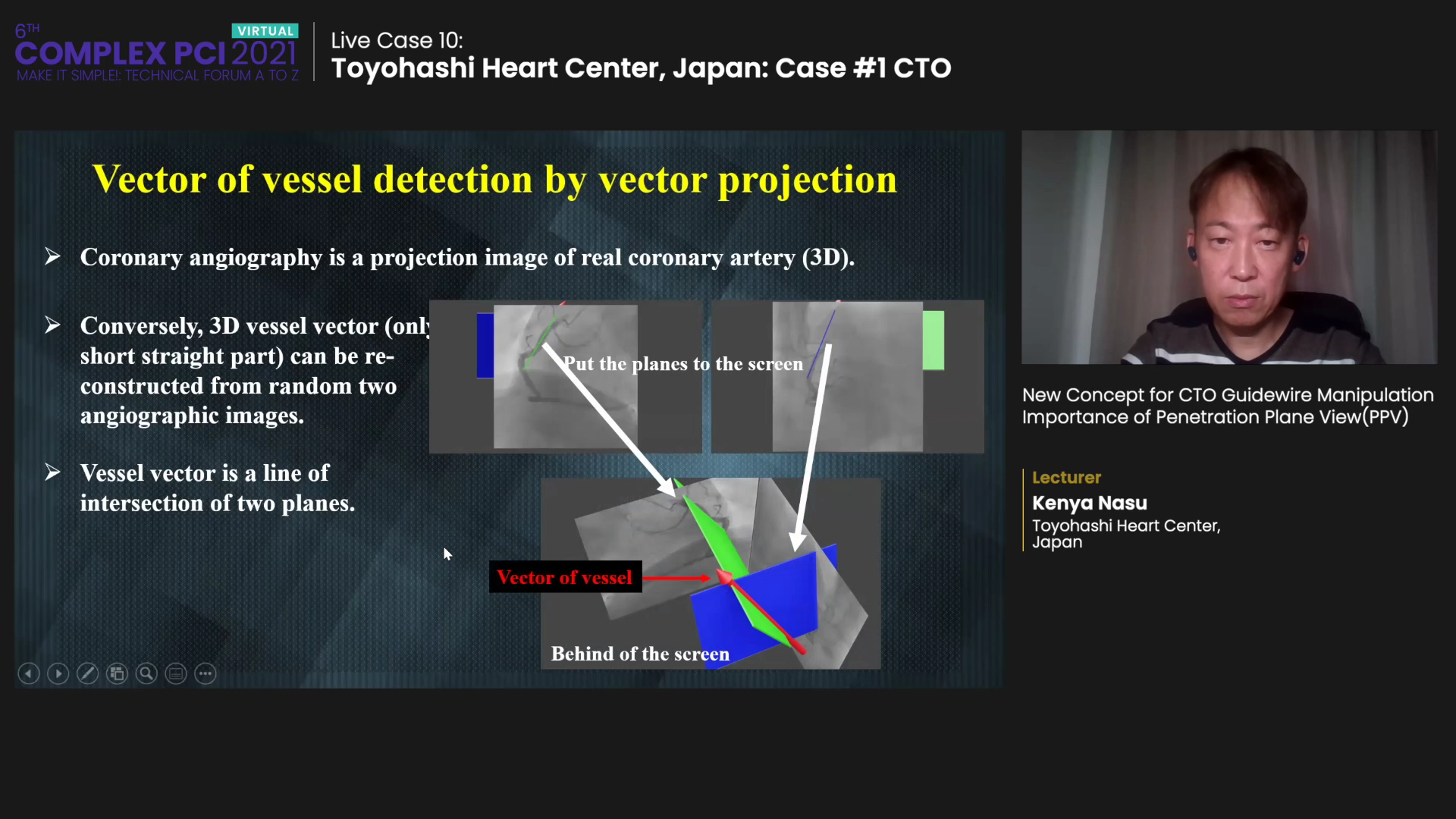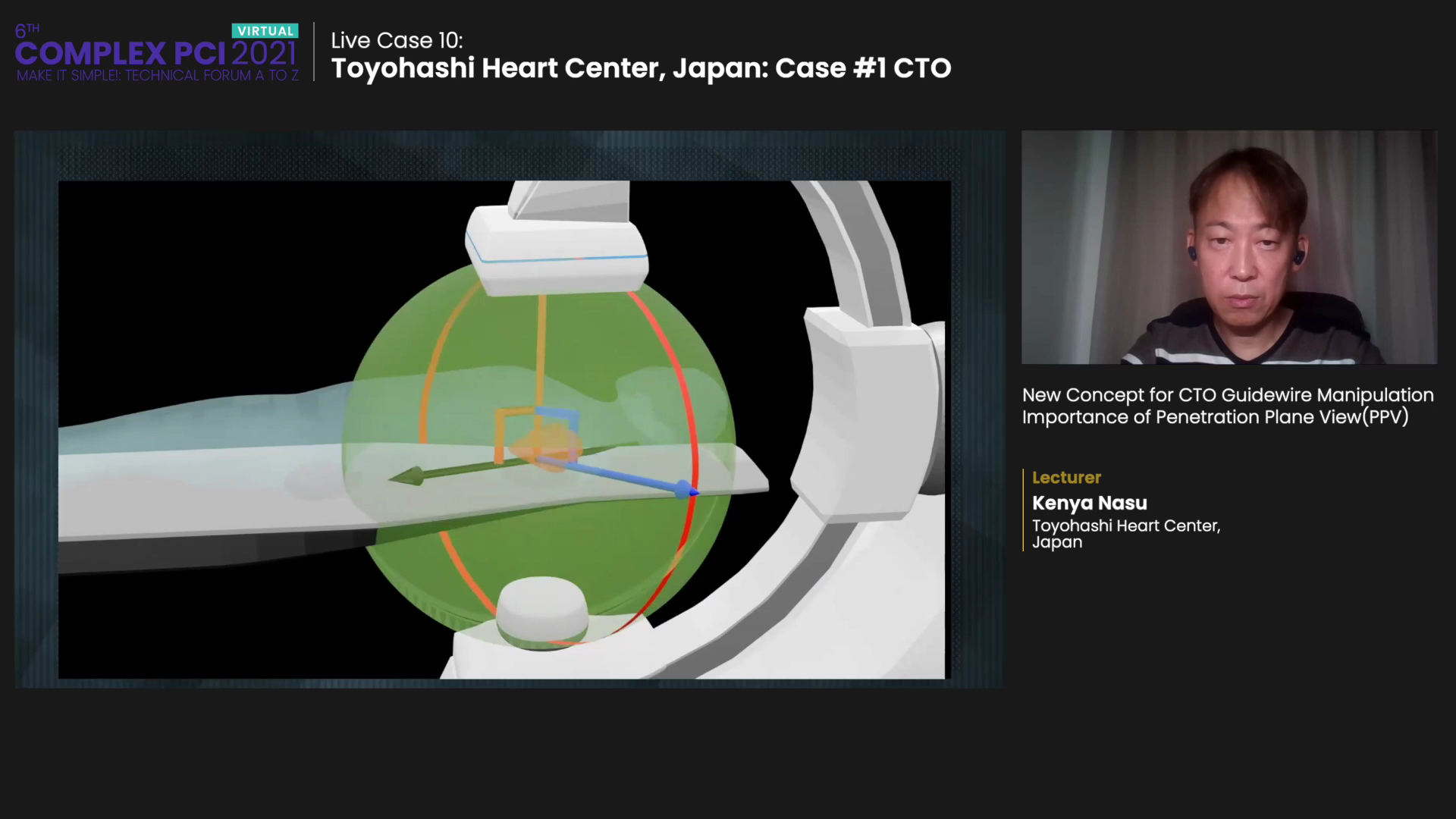New Concept of Angio-based CTO Guidewiring May Simplify Wire Navigation
Theoretical 3D software visualizes CTO segment on perpendicular plane view for easier guidewire control
The difficulty of guidewiring during percutaneous coronary intervention (PCI) for chronic total occlusion (CTO) may get easier with a navigation software that visualizes the CTO segment by projecting angiographic images and reducing reliance on operator experience.
 Kenya Nasu, MD (Toyohashi Heart Center, Toyohashi, Japan) presented a new concept for CTO guidewire manipulation based on angio-based projection of vessels while calling for new guidewire systems like plasma-based devices that can change direction during revascularization at the 6th COMPLEX PCI 2021 Virtual conference on Nov. 26.
Kenya Nasu, MD (Toyohashi Heart Center, Toyohashi, Japan) presented a new concept for CTO guidewire manipulation based on angio-based projection of vessels while calling for new guidewire systems like plasma-based devices that can change direction during revascularization at the 6th COMPLEX PCI 2021 Virtual conference on Nov. 26.

Ą°We need a real and useful guidewiring navigation system in clinical practice. Crossing the guidewire to the distal true lumen is the most important step in CTO-PCI, but guidewires advanced through ĄŪblindĄŊ 3D areas to the distal target with 2D angiographic tools makes CTO guidewiring difficult,Ąą Nasu said. Ą°Guidewire navigation can help visualize the CTO segment, thereby simplifying and standardizing the guidewiring process and decreasing reliance on personal experience.Ąą
Presenting a case of bilateral angiography, Nasu pointed out that traditional practice relies on the anterior-posterior (AP) projection of the left and right anterior oblique (LAO/RAO) views with cranial and caudal angulation because it was thought of as being a Ą°perpendicular view,.Ąą

However, NasuĄŊs analysis showed that the traditional angles donĄŊt fully reflect the perpendicular view, indicating that the appropriate wire direction to get to the distal true lumen is often unidentified with conventional bilateral angiography.
The new proposed navigation system offers a flat 2D or Ą°perpendicularĄą image of the vessel derived from a 3D vessel vector projection to determine the appropriate wire direction for reaching the distal true lumen.

Theoretically, it detects and maps a vessel vector (either the CTO segment or distal true lumen) of a coronary artery by utilizing the angle information of two random angiographic projections and the angles of the vertical and vessel axes (RAO/CRA) to calculate both the vector axis and perpendicular view axis.
Visualizing the CTO segment with guidewire navigation software can standardize the process and decrease reliance on personal experience.
After the vessel vector is calculated with the projection, the perpendicular view rotates around the vessel axis in a full 360-degree motion, effectively straightening the curved line onto a 2D image.
Once the angle information is put in, the two projected images, hereafter called Ą°planes,Ąą intersect at a 90-degree angle to produce a perpendicular crossing of the two planes. The point of intersection between the two planes is identified as the vessel projection.

Once the vessel is projected, operators can manipulate the guidewire in perpendicular view by referencing the Ą°penetration plane,Ąą then proceed to keep the guidewire tip straight on the penetration plane view (PPV), and finally check and change the direction of the guidewire tip from the objective perpendicular view (OPV).
Ą°Guidewiring is simplified once the penetration plane is inserted into the CTO segment as operators can manipulate the wire on the plane, keep it straight on the PPV, and control the wireĄŊs direction from the OPVĄą Nasu said.
Although promising, a significant limitation of this working theory would be that current mechanical guidewires cannot change direction intentionally, meaning mechanical guidewires wouldnĄŊt be able to advance in complex lesions such as calcified CTO even if the navigation system worked in practice.
As a possible solution, Nasu called for a Ą°game-changerĄą in the form of a plasma mediated ablation (PMA) system with a plasma wire designed to resemble a GAIA wire (Asahi Intecc; tip load:3.5g/5g) and a plasma catheter designed to resemble Corsair Pro (Asahi Intecc).
Ą°This strategy paired with new devices such as a plasma-mediated guidewire system can simplify the concept of guidewiring in CTO lesions,Ąą Nasu said. Ą°Visualizing the CTO segment with this guidewire navigation concept can help standardize the process and decrease reliance on personal experience.Ąą

